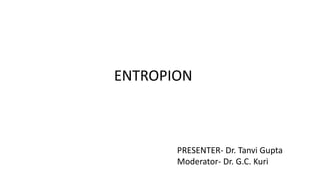
Involutional Entropion-mechanism, evaluation and management (lower lid)
- 1. ENTROPION PRESENTER- Dr. Tanvi Gupta Moderator- Dr. G.C. Kuri
- 2. Etiopathogenesis and management modalities of involutional entropion (4+6) (Dec 2017) Causes of cicatricial entropion. Common techniques for correction of trachomatous upper lid correction (3+7) (June 2017) Discuss pre-operative assessment of entropion. Briefly discuss surgical options for correction of involutional entropion. (3+7) Dec 2012, Dec 2014 (3+7), April 2016 (5+5) Classification and management of various types of entropion (5+5) Dec 2016
- 5. - Inward turning of lid margin against the eye - Redness, irritation, watering, keratitis, corneal perforation Entropion
- 6. Classification 1.Congenital- rare (due to hypertrophy of anterior lamella, mostly self limiting) 2. Acquired a. Involutional (commonest)- mostly lower lid b. Cicatricial- more common in upper lid c. Acute spastic
- 7. 5 basic pathogenic mechanisms Over-riding of pre-septal over pre-tarsal orbicularis oculi -> Anterior lamella and pre-septal O.O. move upwards Horizontal lid laxity -> The orbicularis with its medial and lateral canthal tendons becomes lax Weakness of lower lid retractors -> No longer control the inferior border of tarsal plate Tarsal plate atrophy (tested by palpation of tarsal plate) Atrophy of retrobulbar fat/ fat resorption leading to relative enophthalmos
- 10. INVOLUTIONAL ENTROPION Laxity of tarsus Laxity of medial and lateral canthal tendons Laxity of retractors Over-riding of pre-septal over pre-tarsal orbicularis
- 13. Normally, the lower eyelid retractors maintain the lower eyelid margin in proper orientation. However, attenuation of the eyelid retractors (capsulopalpebral head of inferior rectus and inferior tarsal muscle) in the lower eyelids allows the inferior border of the tarsus to ride forward and superiorly, with the eyelid margin rotating inward Enophthalmos- entropion, prominent eye- ectropion develops Horizontal lid laxity common in both- Lateral tarsal strip can be done for both Posterior lamella shortening- inturning, anterior lid shortening- ectropion Activity of orbicularis- orbicularis action> retractors entropion Orbicularis lax- ectropion
- 14. Pre-op evaluation to determine etiology in case of entropion Involutional entropion is generally noted in individuals of older age group with horizontal laxity of the eyelids associated with a hump on lower eyelid due to overriding of preseptal orbicularis over the pretarsal part. It is often associated with absence of the downward excursion of the eyelid in downgaze due to weakness of the lower lid retractors. Cicatrical entropion is seen in patients with variable amount of tarsoconjunctival lamellar scarring. The digital eversion test can be done to distinguish cicatricial entropion from involutional entropion. Digital eyelid traction is applied to return the eyelid to a normal anatomic position. Th is corrects the abnormal margin position in involutional entropion but not in cicatricial entropion. Entropion is multifactorial in origin. Th e preop evaluation is directed towards identifying each factor that is contributing to its development in a particular patient so that the most suitable surgical procedure is selected. We evaluate the age of the patient, history of trauma, position of lid margin, laxity of lid tissues, presence of trichiatic lashes and corneal status. The diagnosis of entropion is usually straightforward. The goal of eyelid examination is to determine the type of entropion. First thing is to assess if the entropion is cicatricial. Usually the scarring of conjunctiva and tarsus is obvious. Also, there is more resistance on turning the inverted lid to its normal position. If it is not cicatricial, the entropion is involutional.
- 15. Over-riding of pre-septal over pre-tarsal O.O. If the entropion is not obvious at the time of examination, the patient should be asked to squeeze the lids/ forceful closure of lids, this usually makes the entropion manifest After a forceful lid closure/blink -> entropion will manifest Hump on lower eyelid due to over-riding of pre-septal over pre-tarsal O.O.
- 16. In the snapback test, downward traction is applied to the lid and then released. A normal lid returns to its normal position against the globe promptly but in involutional entropion the lid continues to hang down until a blink. Lid distraction test is performed by pulling the central lid away from the eye. If it can be pulled more than 6 mm away from the globe, lid laxity is present.
- 17. Lid distraction test – tests the amount of lengthening and laxity present Snap back test
- 19. There are some other subtle signs as well; the lower eyelid often rides above the inferior limbus and there may be a white line seen in the inferior fornix signifying disinsertion of retractors • deeper-than-normal inferior fornix • reverse ptosis of the lower eyelid (lower eyelid margin sits higher than normal) • little or no inferior movement of the lower eyelid on down gaze (diminished lower eyelid excursion)
- 20. Degree of keratopathy Underlying intra-ocular conditions like visually significant cataract Fitness for local anaesthesia
- 22. THANK YOU
Editor's Notes
- Upper lid retractors – Levator Palpebrae superioris and Muller’s muscle Lower lid retractors- Capsulopalpebral head of inferior rectus muscle and Inferior tarsal muscle
- The anterior leaf is composed of skin and orbicularis an the posterior of tarsus and conjunctiva